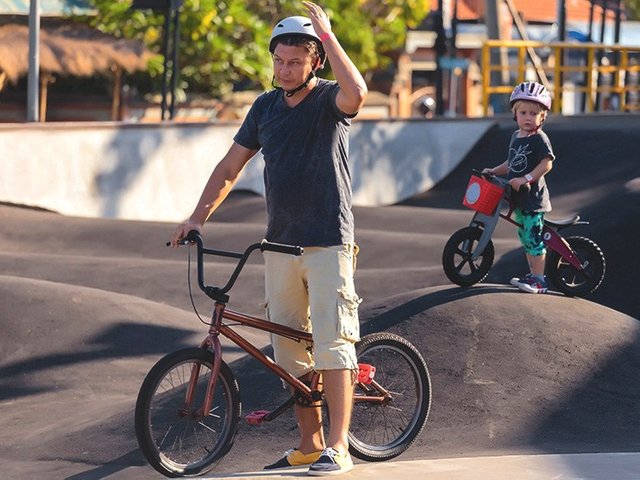New Exercise Guidelines are Out—Here is the Mix of Aerobics and Weight Training Experts Recommend
The revised Physical Activity Guidelines for Americans lays out exactly how much aerobic (and other exercise) you should be getting each week.
Biking is a great way to stay active. Getty Images
Americans are failing when it comes to being physically active, putting themselves at risk of chronic diseases and early death.
Health officials are hoping that an update to the Physical Activity Guidelines for Americans will convince Americans to get moving.
This second edition is very similar to the previous guidelines, but puts more emphasis on the health benefits of physical activity.
It also adds guidelines for 3- to 5-year-olds. And lets you count bouts of exercise shorter than 10 minutes toward your weekly goal — a much-welcome goal for some.
“We’re finally at the point where we can say that any duration of movement, as long as the intensity is moderate or vigorous, is meaningful,” said Panteleimon Ekkekakis, PhD, FACSM, a professor of kinesiology at Iowa State University.
He said this fits with recent research showing that too much sitting is harmful to your health, even if you’re meeting the exercise guidelines.
Ekkekakis also thinks the message of “sit less, move more” will be easier for Americans to remember and take action on.
Still, he questions whether updating the guidelines is enough to improve Americans’ health.
Many people didn’t know about the previous guidelines. And even when they know exercise is good for them, they still fall short, said Ekkekakis.
Part of this may be due to the way the country approaches physical activity, something evident in the guidelines.
“Only children and adolescents are encouraged to do activities ‘that are enjoyable.’ For all other groups, the emphasis is apparently on health promotion — do it because it’s good for you,” said Ekkekakis.
So what’s the solution? Probably too many options to cover here, but Ekkekakis highlighted an important one.
“I would like to see pleasure and enjoyment become the key ‘selling point’ for all age groups,” he said.
In case you’re wondering how much and what kinds of physical activity you should be aiming for, here’s a summary of the new guidelines to help you get moving.
Just don’t forget to do what kids do — find activities “that are enjoyable.”
Children ages 3 to 5 years
Children should be physically active throughout the day, with a variety of activity types.
Children and teens ages 6 to 17 years
School-aged children and adolescents should do 60 minutes or more a day of moderate-to-vigorous intensity physical activity. This should include the following:
Aerobic activity: Most of the 60 minutes should be moderate- or vigorous-intensity aerobic activity, with vigorous-intensity aerobic activity on at least 3 days a week.
Muscle-strengthening activity: At least 3 days a week of weight-lifting or resistance exercise that targets all the major muscle groups of the body — legs, hips, back, abdomen, chest, shoulders, and arms.
Bone-strengthening activity: At least 3 days a week of bone-strengthening activities, such as jumping rope or running.
Adults ages 18 to 64 years
Adults should spend less time being sedentary and more time moving. Every little bit of physical activity counts, including the following:
Aerobic activity: At least 150 to 300 minutes a week of moderate-intensity physical activity; or 75 to 150 minutes a week of vigorous-intensity physical activity; or some combination of both. Ideally, this should be spread throughout the week. Additional health benefits are gained by doing extra physical activity during the week.
Muscle-strengthening activity: At least 2 days a week of moderate- or vigorous-intensity weight-lifting or resistance exercise that targets all the major muscle groups of the body — legs, hips, back, abdomen, chest, shoulders, and arms.
Intensity: Moderate-intensity activities include walking briskly, playing volleyball, or raking the yard. Vigorous-intensity activities include running, carrying heavy groceries, and doing a strenuous fitness class. Many activities vary in intensity depending on the effort required.
Adults 65 years and older
Older adults should follow the same guidelines as for younger adults. If they cannot meet these because of chronic health conditions, they should be as physically active as possible.
Multicomponent physical activity: Some of the weekly physical activity should include more than one type of physical activity, such as aerobic, muscle-strengthening, and balance training. Some examples are ballroom dancing, walking backward, and standing on one foot while doing a biceps curl.
Intensity: Older adults should use their level of fitness to determine the effort for physical activity. For example, on a scale of 0 to 10, where sitting is 0 and 10 is maximum effort, moderate-intensity activity is a 5 or 6. At this level, you should be able to talk, but not sing, during the activity.
Women during pregnancy and the postpartum period
Women should talk with their healthcare provider about whether they need to adjust their physical activity during pregnancy or after the child is born.
Aerobic activity: Women should aim for at least 150 minutes a week of moderate-intensity physical activity during pregnancy and the postpartum period. Ideally, this should be spread throughout the week.
Intensity: Most women who were active before becoming pregnant can safely continue at that level during pregnancy.
Adults with a chronic health condition or disability
Adults with a chronic health condition or disability should follow the same guidelines as for adults age 18 to 64 years. If they cannot meet these, they should be as physically active as possible.
Those with a chronic health condition should talk with their healthcare provider about the types and amounts of physical activity that are appropriate for their condition.
